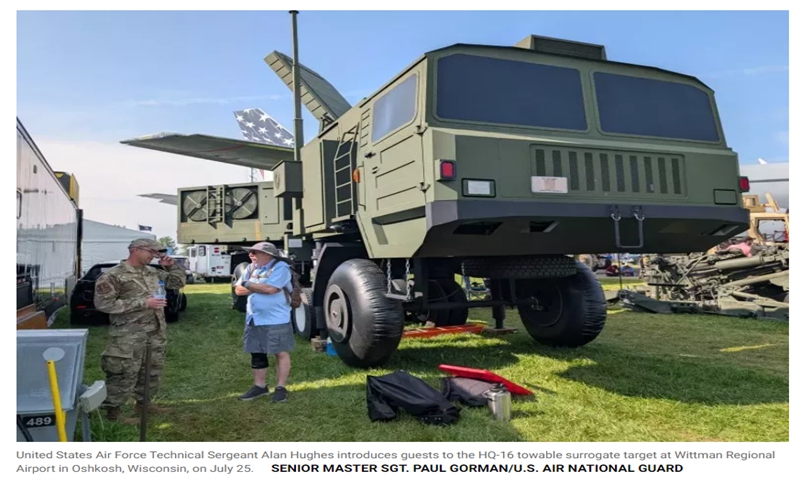In late July 2025, visitors at the Experimental Aircraft Association’s ‘AirVenture Show’ found themselves face-to-face with something unexpected: a life-sized replica of a Chinese Surface to Air Missile System.
The United States military publicly unveiled a mockup of a Chinese HQ-16 surface-to-air missile system, drawing attention at this year’s Experimental Aircraft Association ‘AirVenture Show’ in Oshkosh, Wisconsin.
Shown for the first time on July 25, the full-scale replica, described as an “HQ 16 towable surrogate target,” was part of a broader display by the Wisconsin Air National Guard at Volk Field’s Combat Readiness Training Center.
A photo released by the Wisconsin National Guard confirmed the system’s presence at Wittman Regional Airport, where the event was held.
This surrogate is one of several used by the US military to mimic foreign air defense systems for pilot training, helping aircrews prepare for potential combat scenarios against adversaries like China.
Visually, it replicates the radar vehicle of an HQ 16 battery, with the radar dish clearly raised at the rear, suggesting it’s tailored for exercises involving electronic detection and targeting.
The HQ 16
The HQ 16, known by its NATO designation CH-SA 16, is a medium-range SAM system developed by China and based heavily on Russia’s Buk missile family.
Deployed initially at sea on People’s Liberation Army Navy (PLAN) vessels, land-based versions followed around 2011. Early variants had a reach of about 40 km; newer models now extend that to approximately 75 km, making it one of the more widely deployed SAMs in China’s arsenal.
Notably, the HQ 16 has also been exported, most prominently to Pakistan, where it is designated as LY 80. The system reportedly saw deployment during the brief but intense border skirmishes between India and Pakistan in May 2025, although concrete assessments of its performance remain limited.
Wreckage of an HQ-16 SAM in Pakistan, likely expended during the drone attack on Lahore Cantt on 8th May in which an HQ-9 Air-defence system Mobile command post was liquidated. pic.twitter.com/p1M06us97N
— Choice of Inevitability (@Mark99xm) May 20, 2025
Given its expanding footprint and layered threat profile, capable of targeting aircraft, cruise missiles, and drones at medium altitudes, the HQ 16 poses a meaningful operational challenge for any air force.
For US pilots, particularly those flying stealth fighters like the F-35, understanding the signature, radar behavior, and operational layout of such systems is critical. That’s where the mock-up comes in.
Why Build A Replica?
The HQ 16 surrogate on display in Wisconsin wasn’t just a prop. It’s part of a sophisticated training strategy that aims to replicate potential adversary systems as accurately as possible.
The mock-up mirrors the physical structure of the HQ 16’s transporter erector launcher (TEL) vehicle, complete with a raised radar unit mounted at the rear.
More than just a visual training aid, the replica is fitted with embedded heaters and reflective panels to simulate thermal and radar signatures, allowing fighter aircraft to practice electronic detection and sensor-based identification in near-combat conditions.
“People often know our aircraft, but don’t always see what it takes to get them into the fight,” said Technical Sergeant Alan Hughes, a vehicle maintenance specialist at Volk Field. “This HQ 16 target gives a small glimpse into the behind-the-scenes work that keeps our pilots combat-ready.”
A segment from the video that shows a ROKAF F-35A dropping an inert GBU-12, which scores a direct hit on a moving target (a surrogate ballistic missile TEL) at the Pilsung Firing Range. https://t.co/dVJrlB4NJf pic.twitter.com/t7brYSh2TL
— Guy Plopsky (@GuyPlopsky) April 19, 2024
These training tools are meant to support more than just recognition; they help validate how US weapons and onboard sensors behave in the presence of actual threat profiles. When pilots engage such targets, they are not simply rehearsing a drill; they are building muscle memory and cognitive responses that could prove decisive in a real-world confrontation.

The Strategic Shift
For decades, US training scenarios centered on simulated versions of Soviet and Russian SAM systems like the SA-1, SA-6 6 and SA-20.
That made sense during the Cold War and its aftermath. But in recent years, the Pentagon’s strategic focus has shifted sharply.
With China now labeled the ‘pacing threat’ and ‘pacing challenge’ in US defense doctrine, Washington is recalibrating its training efforts to reflect the realities of potential confrontation with the People’s Liberation Army (PLA). The HQ 16 mockup is just one part of this shift.
During July 2025 alone, the US participated in two major Indo-Pacific military exercises. The multinational Talisman Sabre in Australia and the US Air Force’s new Department-level Exercise, described as a ‘first in a generation’ internal war game. Both were designed with China in mind.
As defense analyst David Cenciotti noted, high-resolution satellite imagery has previously captured similar mockups at US test ranges. “The newest mockups all seem to replicate Chinese military equipment,” he told Newsweek.
The trend is clear: American training is evolving to reflect Beijing’s growing military capabilities, especially in air defense.
China’s Counter Mirror: US Decoys In The Desert
China isn’t staying behind in the game of military simulation. Just as the US builds mockups of Chinese missile systems for pilot training, Beijing has been doing the same with American hardware in its sights.
Satellite images have revealed what appear to be full-scale replicas of advanced US fighter jets, including the F-35 and F-22, stationed at a mock airfield in a remote desert region of northwestern China.
These decoys are believed to be used for target practice and missile testing, offering Chinese forces the opportunity to train against the outlines and signatures of America’s most advanced stealth aircraft.
But it doesn’t stop at aircraft. In the vast stretches of the Xinjiang desert, China has also constructed life-sized mockups of US Navy warships, including Gerald R. Ford-class aircraft carriers and Arleigh Burke-class destroyers.
Often dubbed ‘desert warships’, these targets are part of a sophisticated weapons testing zone used to simulate real-world maritime strike scenarios.
The key focus of these drills? Fine-tuning the targeting accuracy of long-range weapons like the DF 21D and DF 26, missiles often referred to as ‘carrier killers’ due to their role in China’s anti-access/area denial (A2/Ad) strategy. These mockups allow the People’s Liberation Army to test and refine missile trajectories and impact precision against high-value naval targets.
In this sense, both nations are engaged in a kind of shadow training war – each building and refining decoys of the other’s assets, each preparing for a high-end fight that both sides hope to deter, but must nevertheless prepare for.

How Surrogate Targets Shape Combat Readiness
Surrogate targets like the HQ 16 mockup serve multiple training functions. At the most basic level, they give aircrews a full-scale visual to help with identification.
But many are designed to go further, replicating key electronic signatures, like radar and infrared emissions that aircraft sensors must detect and interpret in combat.
When grouped together, these decoys can simulate an entire hostile base or air defense network. Because they are towable and modular, they can be rearranged quickly, making every training sortie a new challenge. Pilots are forced to adapt in real time, just as they would in an actual conflict.
These replicas aren’t limited to missile systems. Other commonly simulated platforms include tanks, mobile artillery, radar stations, and fighter aircraft. The goal is to build a training environment that closely mirrors the complexity and unpredictability of a real battlefield.
This type of realism isn’t exclusive to the United States. In June 2025, reports surfaced about an Italian training range hosting detailed replicas of Russian SAM systems like the Pantsir, Buk, Tor, Tunguska, and S-300. These were used to support NATO-aligned forces in training for contested air operations in environments dominated by Russian style air defenses.
Real-World Stakes In A Simulated Arena
At its core, the use of surrogate targets reflects a growing understanding that warfare is as much about preparation as it is about technology. In a future conflict, particularly in the Indo-Pacific, the side that adapts faster and identifies threats more accurately could gain a crucial edge.
By investing in high-fidelity mockups of Chinese systems like the HQ 16, the US is signaling that it’s not only watching China’s military buildup but actively preparing for how to counter it. And China, in turn, is clearly doing the same.
As of now, neither side is looking to start a war. But both are making sure their forces are trained for one, just in case.
- Shubhangi Palve is a defense and aerospace journalist. Before joining the EurAsian Times, she worked for ET Prime. She has over 15 years of extensive experience in the media industry, spanning print, electronic, and online domains.
- Contact the author at shubhapalve (at) gmail.com




